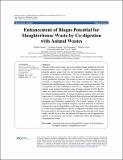Enhancement of Biogas Potential for Slaughterhouse Waste by Co-digestion with Animal Wastes

View/
Date
2021-05-25Author
Chebett, Elijah
Kiprop, Ambrose
Namango, Saul
Arimi, Milton
Kiriamiti, Kirimi
Metadata
Show full item recordAbstract
The aim of the current study was to investigate biogas production from the
slaughterhouse waste codigested with animal wastes. Slaughterhouses
generate organic wastes that are environmentally hazardous due to high
contents of biological contaminants. The use of anaerobic digestion of the
slaughterhouse waste can achieve twin objectives of waste treatment and
energy production as biogas. The process is however, limited by low biogas
potential of slaughterhouse waste. The study evaluated the effect of codigesting the slaughterhouse, chicken and pig wastes on biogas potential. The
co-digestion test with combination ratio of 1:1, slaughterhouse waste and
chicken waste produced the highest value of biogas potential of 636 L/kg-VS,
which was almost double that from pure slaughterhouse waste. In addition,
the substrate biodegradability, the biogas productivity and the yield were most
improved at 1:1 co-digestion. The digestate from the process had high nutrient
contents and a maximum of; 0.8, 2.6 and 2.7% of dry matter for total nitrogen,
phosphate and Potassium respectively. The kinetic analysis of the codigestion process using modified Gompertz equation indicated a correlation
between the waste biodegradability and biogas yield. The enhancement of the
C/N ratio in the slaughterhouse waste by co-digestion with these wastes could
be responsible for the improvement of the biogas production and yield. Future
studies should focus on how the nutrient rich digestate can be appropriately
applied as bio-fertilizer and on how co-digestion affects the pathogens in
slaughterhouse wastes.
